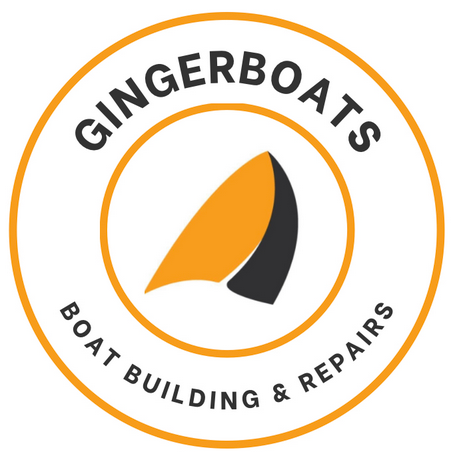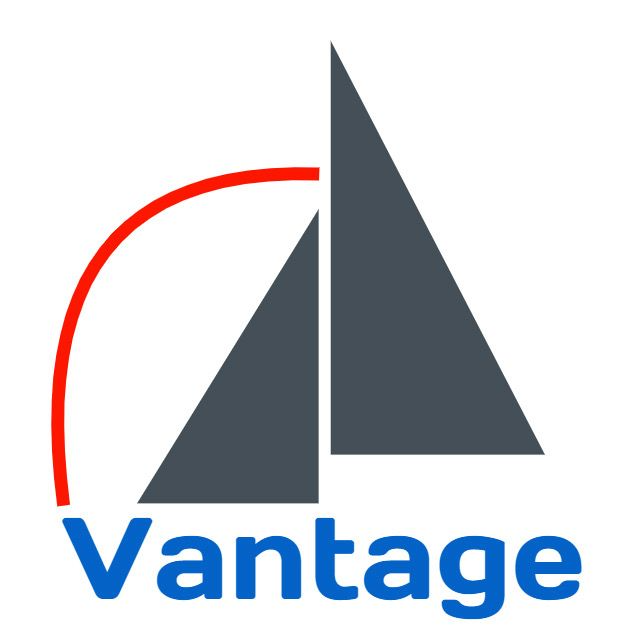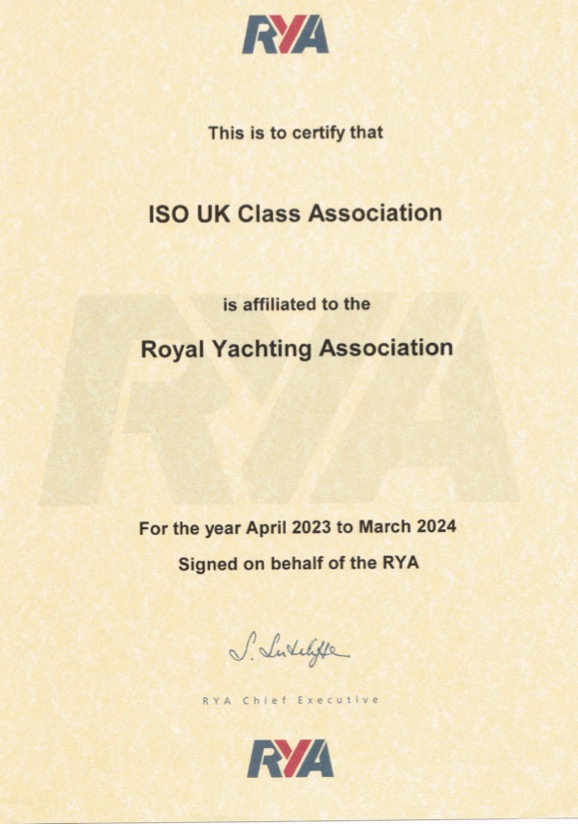ISO Class Rules (2015)
ISO DINGHY CLASS RULES Revised SEPTEMBER 2015
Contents
SECTION 1 - Intention and Interpretation........................................................... 1
SECTION 2 - Protection of the One-Design and Measurement........................... 1
SECTION 3 - Optional & essential items............................................................. 2
SECTION 4 - Alterations, Repairs and Replacements.......................................... 3
SECTION 5 - Use of Detachable Wings................................................................ 4
SECTION 6 - Membership Certificate.................................................................. 5
SECTION 7 - Sail Numbers................................................................................... 5
SECTION 8 - Specific Prohibitions....................................................................... 5
SECTION 1 - Intention and Interpretation
1.1 The intention of the Class Rules shall be to maintain a strict one-design class in which racing provides a true test of sailing skills where no perceived advantage is gained by the addition or replacement of any equipment other than that permitted in Section 3.
1.2 It is the intention of the Class Rules to endeavour to provide equality of advantage to as wide a crew weight range as is practical with the least administrative complexity.
1.3 The official language of the class is English and the English text shall prevail in the event of a dispute over translation.
1.4 The executive committee of the ISO Class Association, in consultation with the Copyright Holders, shall be empowered to apply their own interpretation of a Class Rule, pending ratification according to the constitution.
SECTION 2 - Protection of the One-Design and Measurement
2.1 Only those companies currently holding Licenses to manufacture and market the ISO shall be entitled to sell or distribute the ISO and unique ISO equipment. This applies to new ISO boats and new unique ISO equipment only. General replacement chandlery such as ropes and blocks may be purchased from any chandler of an individual boat owners choice.
2.2 Licensees shall be required by the License to produce boats and equipment in accordance with the Official Drawings and Specifications issued by the Copyright Holders and in accordance with these rules.
2.3 Hulls and other components moulded in Glass Reinforced Plastic (GRP) or other material specified by the Copyright Holders shall originate only from official moulds approved and registered by the Copyright Holders.
2.4 Each boat will be sequentially issued with a unique registration number which will be marked on the hull.
SECTION 3 - Optional & essential items
The following optional items only are permitted.
(a) One compass, of any type, may be attached to any part of the boat or spars as long as the watertight integrity is not compromised.
(b) A mechanical wind indicator may be attached to the mast, rigging or hull as long as the watertight integrity is not compromised.
(c) Running rigging (ropes and lines). All cordage may be replaced with material of the owners choice, in size and material, which may be tapered as necessary.
(d) Standing rigging. The shrouds and jib halyard must conform to manufacturer’s specification. The rope tail may be replaced with rope of the owner’s choice.
(e) The choice of trapeze ring, adjustment, retraction system and handle shall be unrestricted except that no additional fittings may be fixed to the hull or spars. The trapeze wire may be replaced entirely, or in part, by a suitable rope provided that the method of attachment to the mast remains in accordance with the original design.
(f) The tiller extension, tiller and rudder stock shall be unrestricted except that the blade shall remain capable of lifting whilst the stock is attached to the hull.
(g) The rudder blade shall be supplied by the Licensee or their agents or any other supplier to a design, profile and material approved by the ISO Class Association Executive Committee or copyright holders. The design of the blade shall remain unchanged except that alternative fixing points may be used, above the waterline, to facilitate raising and lowering in the event that an alternative stock is used in (f) above.
(h) Fairleads may be added, or removed, to/from any cam cleats
(i) Shackles, pins, rigging links, rope stoppers, rings, shock cord, blocks, cleats, wedges, adhesive tape and storage receptacles are unrestricted except that if they are permanently fixed to the hull, or spars by screws, bolts, rivets or similar permanent fixing method they shall be of similar size to those originally fitted/supplied by the Licensed Manufacturer.
(j) Additional fixing holes can be drilled in the hull or spars to relocate a fitting and for a compass and or camera bracket. The holes drilled shall not compromise the structural or watertight integrity of the hull or spars. Any unused holes must be filled and made watertight.
(k) Non-Slip materials not exceeding 3mm in depth may be added to the hull or wings.
(l) A length of cord or elastic shall be attached to the dagger board and either an existing hull fitting or mast, whilst racing, in order to prevent the loss of the board in the event of capsize.
(m) One access hatch, to designer specification, may be added to the rudder post as long as the watertight integrity of the hull is not affected.
(n) The use of material and method to adjust the mainsheet strop(s) is unrestricted except that no additional holes may be drilled in the hull.
(o) Toe strap locations may be changed provided that existing, heavy duty, hull mounting points are used and as long as the watertight integrity and strength of the hull is not affected. The choice of webbing is unrestricted.
(p) Booms may be obtained from any supplier. They may be made of ~76mm Aluminium or Carbon Fibre and must locate on the standard mast gooseneck. The method and location of fittings for sheet, kicking strap take off and clew is unrestricted provided that the take off points along the length of the boom match the design of a standard boom. A detailed specification of the ISO boom can be obtained from the ISO website in the Rigging and Tuning area of the downloads at:
https://www.isoracing.org/info/rigging/405-boomspec
SECTION 4 - Alterations, Repairs and Replacements
4.1 Alterations
Any alteration to the hull form, deck form, construction, spars, sails, rigging or equipment as supplied by the manufacturer, in accordance with the specification of the copyright holders, except as specifically authorised by these rules, shall be prohibited.
4.2 Repairs
Damaged items shall be repaired in the way that best reproduces the original shape and construction of the item. Items which have been repaired in a way that alters the shape or any other characteristic pertaining to performance, beyond minor and unavoidable variations, which do not affect performance, shall not be permitted. (Definition: Repairs to trailing edge of foils shall ensure trailing edge width is a minimum of 2mm at all points).
Additional inspection hatches are allowed only if required to allow repair of the hull, so long as the watertight integrity of the hull is maintained.
4.3 Replacements
All replacement parts not specifically described in the rules may only be obtained from a Licensee or their agents or any other supplier approved by the ISO Class Association Executive Committee or copyright holders to distribute unique ISO equipment. The ISO Class Association Executive Committee may approve additional suppliers or manufacturers at anytime.
Common parts such as rope,cleats,blocks may be obtained from any chandler.
Sails may only be supplied by Licensees or their agents
Commencing from such date as shall be fixed by the ISO Class Committee there will be an additional sailmaker to Hyde Sails namely Rooster Sailing. The addition of Rooster Sailing is subject to prior approval by the Technical Committee of the ISO Class.
Existing Sobstad sails (manufactured prior to the 1st April 2007) may continue to be used indefinitely .
Hyde sails may continue to be used indefinitely
(Notes:
The ISO Class Association is currently an ISO licensee.
Rooster Sailing Ltd. was approved by the ISO Class Association on 1 March 2010 as suppliers of all ISO parts other than sails.
Rooster sails were approved on 14 August 2010 as stated above.
Rooster Sailing Ltd. was approved by the ISO Class Association as suppliers of Rooster sails on 16 August 2010.
Vantage Sailing Ltd. was approved by the ISO Class Association on 6th December 2012 as suppliers of Hyde sails.
Vantage Sailing Ltd. was approved by the ISO Class Association on 6th December 2012 and 6th April 2013 as suppliers of all ISO Parts other than sails.)
In the event that suppliers become approved during the year the ISO Class Association Executive Committee may publish the details on the Class web site and in a Class e-mail addressed to all registered Class Members. The choice of supplier and the component supplied will be included in the next Class ballot or AGM agenda, whichever is the earlier.
4.4 Permitted Modifications
The modification of existing boats in line with the specification of current production boats shall be permitted.
SECTION 5 - Use of Detachable Wings.
(1) The addition of the detachable pair of the wings shall be mandatory for crews whose combined weight is below 135kg unless the trapezing member of the crew exceeds 78kg.
(2) The addition of the wing will only be permitted if the trapezing crew weighs less than 78kg.
(3) A competitor’s weight and a crew’s combined weight, will be determined by an official set of scales provided at all class open events. Weights will be measured with competitors wearing normal indoor attire (no footwear or coat), but where applicable, competitors may opt to be weighed in as little clothing as modesty will allow. Competitors may opt for an official weighing before the start of an open meeting. Such recorded weight will then be deemed to be their sailing weight for the entire event.
(4) All competitors will be obliged to declare, on entering a class open event, the wing configuration with which they will be sailing for the whole of that event and no change to that shall be permitted unless a change of crew shall be considered by the Committee Members present at the event at their sole discretion to have become necessary by reason of injury or illness.
(5) The declaration referred to in Section 5(4) shall be one of the following:-1 Mandatory wings under Section 5(1);2 Optional wings under section 5(2);3 No wings
(6) The wearing of weight jackets by either crew member is prohibited, as is the wearing of any clothing specifically worn for the purpose of increasing weight. This shall not prevent the wearing of a water container for the use of hydration up to a maximum capacity of 1 litre and total weight of 1.2 kilo.
(7) Only standard ISO wings may be raced at ISO Class Association events, meeting the copyright holder’s specification. In addition to weighing the crew, wings may also be weighed before or after a race. See Note i.
Note i: Competitors who are in any doubt should opt to be officially weighed before the start of a meeting in order to ascertain that they are sailing within the prescription of rule 5. In the event of a protest against a competitor not having an official weighing, the weight recorded at any meeting to hear that protest will be taken as the sailing weight. If it is discovered that the rule has been contravened, for whatever reason, the competitor will be liable to disqualification from all races previously sailed in that series.
SECTION 6 - Membership Certificate
(1) An ISO shall not be permitted to race without a valid Class Membership Certificate being held by either helm or crew or both.
(2) A Membership Certificate is only valid provided that it has been signed by the current ISO Class Membership Secretary. Alterations made to the certificate that have not been endorsed by the current ISO Class Membership Secretary will make the Certificate invalid.
(3) Upon the acquisition of an ISO or annual renewal of the Class Membership Certificate, a completed application form must be returned to the ISO Class Secretary together with the appropriate fee, where applicable. This application form will invite the Member to specify:
(i) (deleted)
(ii) (deleted)
(iii) The boat and it’s equipment comply with the Class Rules applying at the time of the race.
SECTION 7 - Sail Numbers
The boat registration number (see Section 2.4) shall be the sail number of the boat and be displayed clearly on each side of the mainsail, and located either:
· Hyde Sails – Immediately above the second batten from the bottom of the sails, or
· Sobstad Sails – either side of the second batten from the bottom of the sail.
The first number shall be approximately 150mm from the leach of the sail with the Starboard side a minimum of 60mm above the number on the Port side and be solid, readily identifiable and of the following minimum dimensions:
Height 300mm
Width 200mm (except numeral 1)
Thickness 45mm
Spacing 60mm
Sail numbers shall not be required on the Jib or asymmetric spinnaker.
SECTION 8 - Specific Prohibitions
(1) It is prohibited to adjust the shroud lengths whilst racing.
(2) All electronic equipment, with the exception of time keeping equipment and electronic compass that may also indicate heading and wind shifts, shall be banned.
(3) An ISO shall always be raced by two persons.
(4) Dagger boards constructed of GRP are banned on all boats with a registered number greater than 600. Effective 1.1.1999.





